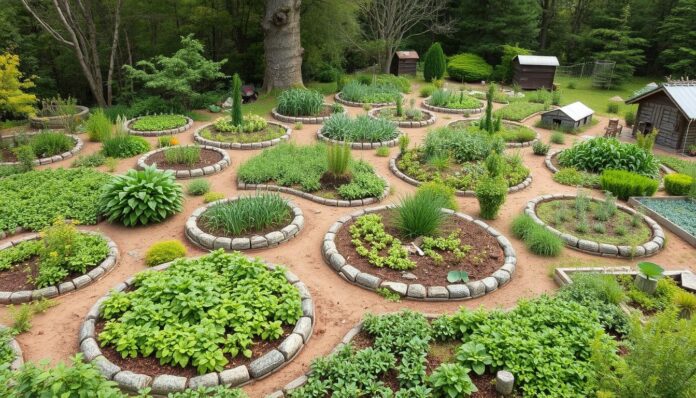Imagine creating a permaculture project that not only grows but also helps the planet. With permaculture’s circular planning, sustainable design, and regenerative agriculture, it’s possible. Yet, 100% of permaculture project managers struggle with time and money. A well-organized group process can greatly lessen these challenges, making circular planning key to success.
By using permaculture principles, like the PEAR Process, you can boost productivity and efficiency. Setting achievable deadlines and keeping group communication open are vital for effective delegation and management. With permaculture’s circular planning and sustainable design, you can build a system that’s good for both people and the planet.
Key Takeaways
- Permaculture project managers face obstacles related to time and money, but a clear group process can help reduce these obstacles.
- Permaculture circular planning is essential for creating a sustainable and regenerative agriculture system.
- The PEAR Process can increase productivity and efficiency by emphasizing synergy and breaking down tasks into actionable steps.
- Setting realistic deadlines and establishing communication flow within groups are crucial for successful project management.
- Regenerative agriculture can benefit both people and the planet, making it a key component of permaculture design.
- Sustainable design and permaculture circular planning can help mitigate the effects of extreme weather events and climate change.
Understanding Permaculture Principles
Permaculture is a way to design sustainable living systems. It follows three main ethics: caring for the earth, people, and ensuring fair shares. These ethics help in designing everything from small gardens to big farms. They make systems that are good for the environment, people, and the economy.
At the heart of permaculture is ecological planning. It means observing the land to work with nature, not against it. This way, people can design systems that fit their local climate, soil, and ecosystem. Using methods like rainwater harvesting and composting helps reduce environmental harm and promotes a circular economy.
Permaculture design focuses on natural patterns and stacking functions. For example, using spirals and shapes found in nature. A fruit tree can offer food, shade, and a home for wildlife, making it a valuable part of a permaculture system.
Observation is crucial in permaculture design. It helps understand how to work with nature. Observing the land over time, across all seasons, reveals its patterns and needs. This approach ensures systems are tailored to the local climate and ecosystem, working in harmony with nature.
Permaculture design offers many benefits. These include:
- Increased biodiversity
- Improved soil health
- Reduced environmental impact
- Increased food security
By using permaculture principles, people can create systems that are good for the environment, society, and the economy. This is done through ecological planning and circular economy principles, leading to sustainable and regenerative living systems.
Importance of Resource Management in Permaculture
Effective resource management is key for permaculture success. It helps create sustainable and efficient systems. By using regenerative agriculture, we support environmental stewardship and a greener future. This method looks at the whole ecosystem, not just parts.
Resource management in permaculture offers many benefits:
- Less waste and more efficiency
- More money saved and productivity gained
- Stronger communities through sustainable systems
Using regenerative agriculture helps fight urban problems like pollution and waste. For example, in Melbourne, Australia, urban permaculture cut carbon emissions and improved waste handling. The Beacon Food Forest in Seattle turned a city plot into a forest, showing urban permaculture’s power.
Good resource management is vital for permaculture success. It positively affects the environment, economy, and community. By choosing regenerative agriculture and caring for our planet, we build a better future.
Assessment of Land and Resources
Assessing the land and resources is key in permaculture circular planning. It involves checking the soil, water, and native plants and animals. This helps create a design that fits with nature.
Understanding the land’s unique features is important. This includes the slope, soil, and water. For example, a gentle slope can be better than a steep one. This way, the design meets the property’s specific needs.
Some important things to look at include:
- Soil quality and composition
- Water resources and management
- Native flora and fauna
- Aspect and slope
- Climate and microclimate
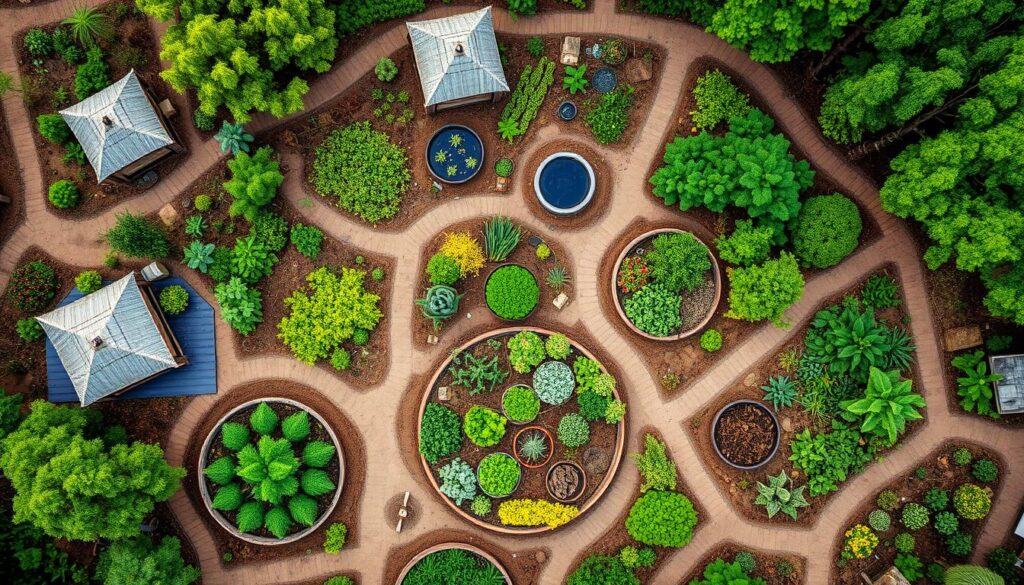
By looking at these factors and making a detailed design, you can create a sustainable ecosystem. This not only helps the environment but also provides food and resources.
| Factor | Importance | Description |
|---|---|---|
| Soil quality | High | The quality of the soil has a significant impact on the health and productivity of the ecosystem. |
| Water resources | High | Access to clean and abundant water is essential for a thriving ecosystem. |
| Native flora and fauna | Medium | The presence of native flora and fauna can help to create a balanced and diverse ecosystem. |
Designing Resource Cycles
Creating a circular economy in permaculture means designing cycles that cut down waste and boost efficiency. This way of caring for the environment uses nature’s solutions to manage resources well. For example, permaculture design processes like GOBRADIME stress making smart choices and checking resources.
Designing cycles also means setting up waste management plans. This includes composting, recycling, and finding new uses for materials to cut landfill waste. Nutrient cycling techniques are key too, keeping soil fertile and cutting down on synthetic fertilizers. Water harvesting systems are vital, collecting and storing rainwater for irrigation and other uses.
- Implementing greywater systems to reuse water from sinks, showers, and washing machines
- Creating compost piles to turn food scraps and yard waste into nutrient-rich soil amendments
- Using rainwater harvesting systems to collect and store rainwater for irrigation and other uses
By using these natural solutions, people can lessen their environmental footprint and help a circular economy grow.
Integrating Renewable Energy Sources
Renewable energy is key in regenerative agriculture. It helps manage land holistically and sustainably. By using solar, wind, and biomass, permaculture projects cut down on fossil fuel use.
In Australia, the Hundred Acres of Permaculture System uses solar and wind power. The Permaculture Research Institute in New Zealand also shows sustainable energy with solar, wind, and micro-hydro power.
Renewable energy fits well with permaculture design. It boosts efficiency and productivity. Here’s how:
- Solar energy uses photovoltaic cells on rooftops or ground arrays.
- Wind power works best in areas with steady winds, for small or big farms.
- Biomass and biofuels offer reliable energy, fitting into existing systems.
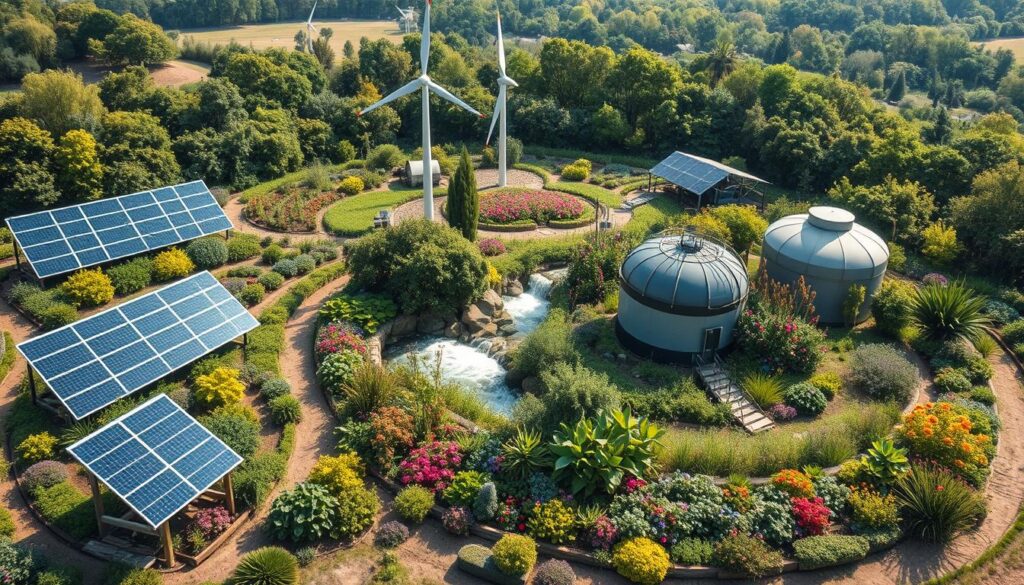
Adding renewable energy makes permaculture projects more self-sufficient. They become more resilient and sustainable. This follows regenerative agriculture and holistic land management principles.
| Renewable Energy Source | Benefits |
|---|---|
| Solar Energy | Less need for fossil fuels, low upkeep costs |
| Wind Power | Best energy output, cuts down on greenhouse gases |
| Biomass and Biofuels | Steady energy source, lowers waste and management costs |
Water Management Strategies
Effective water management is key in permaculture projects. It involves strategies to conserve and use water wisely. Permaculture design processes like GOBRADIME highlight the role of water management. They focus on sustainable and efficient designs.
One important part of water management is permaculture circular planning. It aims to reduce waste and use resources fully.
Effective strategies include rainwater harvesting, greywater recycling, and smart irrigation. These use ecological planning to favor natural and renewable resources. For instance, rainwater harvesting systems collect and store rainwater for non-drinking uses. This cuts down on the need for municipal water.
Nature-based solutions like wetlands and aquaculture systems also help manage water. They promote biodiversity.
Here are some benefits of these strategies:
- Reduced water consumption
- Increased water efficiency
- Improved water quality
- Enhanced biodiversity
By using these strategies, we can make water management more sustainable. This is a core part of permaculture circular planning and ecological planning. It helps lessen the burden on municipal water supplies and encourages nature-based solutions for water management.
| Water Management Strategy | Benefits |
|---|---|
| Rainwater Harvesting | Reduced water consumption, increased water efficiency |
| Greywater Recycling | Improved water quality, enhanced biodiversity |
| Irrigation Techniques | Increased water efficiency, reduced water waste |
Plant Selection for Resource Efficiency
Choosing the right plants is key for a permaculture project’s success. It helps create sustainable ecosystems that waste less and produce more. This method follows sustainable design and regenerative agriculture principles.
A good permaculture system has a mix of plants that work well together. This includes companion planting, where plants are paired to help each other grow. For instance, marigolds with tomatoes can fight nematodes, and basil and mint can make nearby plants taste better.
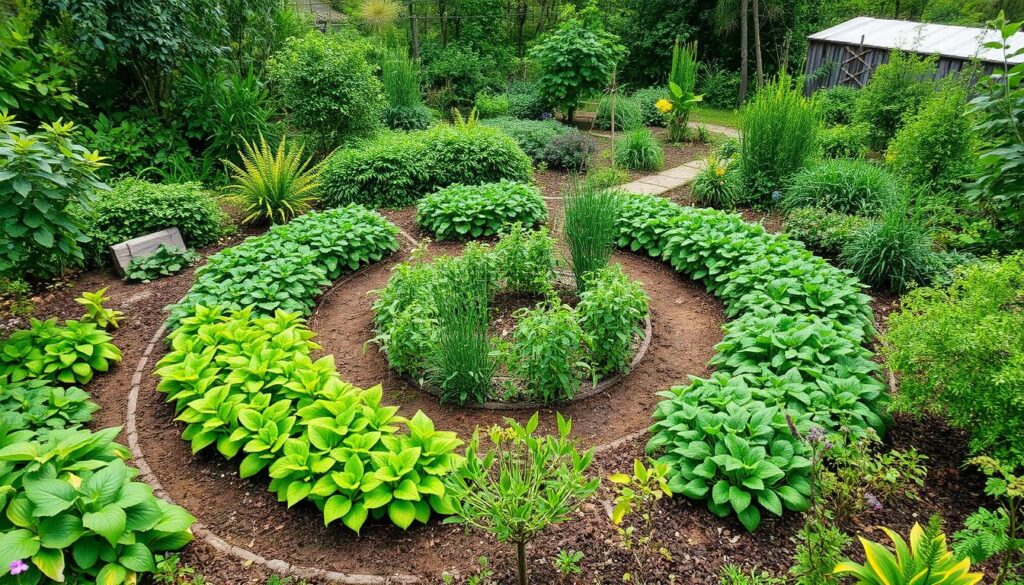
Companion Planting Strategies
Companion planting is vital for a strong and diverse ecosystem. It pairs plants that grow well together, reducing competition for resources. This makes the system more efficient. Here are some examples:
- Legumes with grains to fix nitrogen and improve soil
- Tall plants with shorter ones to use space well
- Plants with fragrances that keep pests away, like basil and mint
Perennial vs. Annual Crops
Choosing between perennial and annual crops is important. Perennials, like fruit trees, give steady yields for years and need less care. Annuals, like vegetables, must be replanted every year and need more work.
Native and Adaptive Species
Using native and adaptive species is crucial for a sustainable ecosystem. These plants fit the local climate and soil, needing less water and care. By using them, permaculture can support regenerative agriculture and environmental stewardship.
Animal Integration in Permaculture
Animal integration is key in permaculture, making systems more sustainable and efficient. It promotes holistic land management, seeing all parts of the ecosystem as connected. This leads to a circular economy, where waste is cut down and resources are used well.
Animals bring many benefits. They can fertilize, control pests, and provide food, boosting biodiversity. For instance, chickens help with pest management, and sheep manage grass and produce manure. This way, permaculture uses nature-based solutions that work well and last.
Benefits of Livestock in Systems
Livestock is vital in permaculture, offering fertilizer, food, and pest control. They make ecosystems more diverse and strong.
Designing for Animal Welfare
It’s crucial to design for animal welfare in permaculture. This means giving them good shelter, food, and water, and keeping them healthy. By focusing on animal welfare, permaculture systems become more holistic and sustainable.
Tools and Technologies for Resource Management
Effective permaculture planning uses tools and technologies to improve sustainable design. It includes innovative gardening tools and software for design and management. These tools make permaculture projects more efficient and productive.
Permaculture uses the right technology to support sustainable design. This can be simple tools or complex systems. For example, rainwater harvesting systems are designed with software to manage water efficiently.
Appropriate Technology in Permaculture
Appropriate technology is key in permaculture. It helps create sustainable and self-sufficient systems. Using renewable energy like solar and wind power is important. It reduces our need for non-renewable resources.
Innovative Gardening Tools
Innovative gardening tools are crucial for permaculture. They help with soil preparation, planting, and harvesting. For instance, composting tools turn waste into fertilizer. This supports sustainable design and ecological planning.
Software for Design and Management
Software is vital for modern permaculture. It helps create detailed plans and track project progress. This software simulates scenarios and predicts outcomes. It aids in making sustainable design and ecological planning decisions.
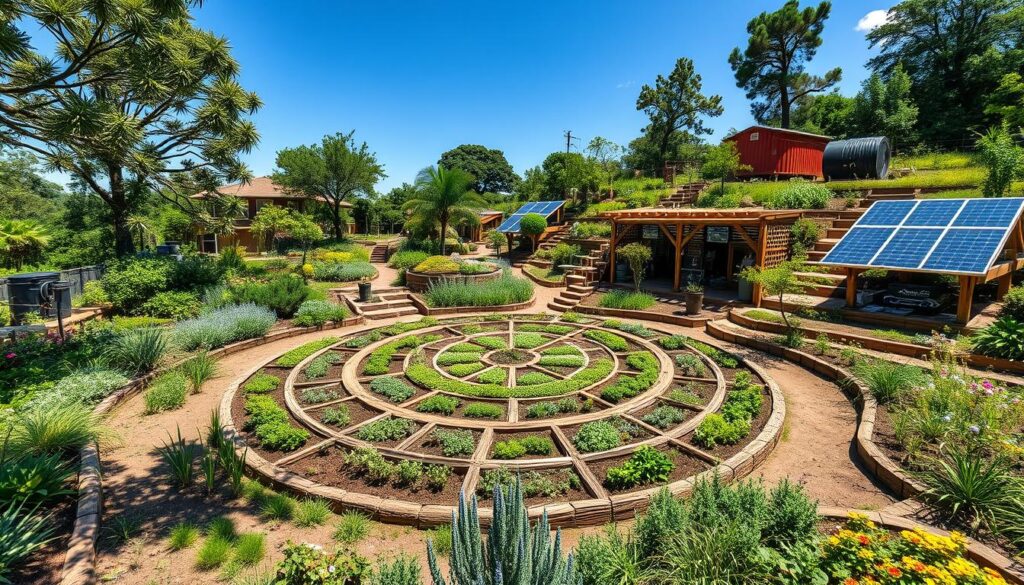
Using these tools and technologies, permaculture practitioners can create efficient and sustainable systems. This contributes to a greener and more resource-efficient future.
| Tool/Technology | Purpose | Benefits |
|---|---|---|
| Renewable Energy Systems | Power generation | Reduced carbon footprint, lower operational costs |
| Composting Tools | Organic waste management | Nutrient-rich fertilizer, reduced waste |
| Permaculture Design Software | Project planning and management | Efficient design, predictive analysis, improved outcomes |
Community Engagement and Participation
Community engagement is key to successful permaculture projects. It builds a sense of ownership and responsibility among members. By working together, people can create sustainable ecosystems. This approach also improves the community’s overall well-being.
Effective strategies include workshops, educational programs, and volunteer opportunities. These help community members share knowledge and resources. This way, they can develop environmental stewardship practices together.
Community engagement in permaculture projects has many benefits. These include:
- Increased sense of community and social connection
- Improved knowledge and skills related to sustainable practices
- Enhanced environmental stewardship and conservation efforts
By embracing community engagement, permaculture projects can drive positive change. They promote regenerative agriculture and holistic land management. This benefits both people and the planet.
Case Studies in Successful Resource Management
Permaculture circular planning is key for managing resources well in many projects. It uses sustainable design and ecological planning to make systems efficient and productive. For example, permaculture farms show how it cuts down waste and boosts biodiversity.
Successful Permaculture Farms
These farms use permaculture circular planning to create closed-loop systems. They minimize waste and use resources wisely. They often use renewable energy, sustainable irrigation, and native species to plan ecologically.
Urban Permaculture Projects
Urban permaculture projects also show the power of permaculture circular planning. They prove that urban areas can be productive and efficient, even with less space. Examples include community gardens, green roofs, and urban agriculture.
Lessons Learned from Failures
Permaculture circular planning has seen successes and failures. Failures teach us about the need for careful planning, community involvement, and ongoing checks. These lessons help improve permaculture planning, making systems more efficient and productive.
| Project | Location | Key Features |
|---|---|---|
| Green Roof Initiative | New York City | Reduced stormwater runoff, increased biodiversity |
| Community Garden | Los Angeles | Increased food production, improved community engagement |
| Urban Agriculture Initiative | Chicago | Created jobs, promoted sustainable design |
Future Trends in Permaculture Resource Management
Permaculture is key in moving towards sustainable practices. It promotes regenerative agriculture and focuses on holistic land management. This approach aims to create ecosystems that are productive, resilient, and diverse.
The integration of permaculture into mainstream agriculture is a big step. It’s part of a shift towards a circular economy. In this system, resources are used efficiently, and waste is minimized.
New techniques and technologies are being developed to support sustainable practices. Policy changes and advocacy also play important roles. They help promote permaculture and regenerative agriculture.
Research and development are ongoing. The goal is to improve yields while reducing environmental impact. This work is crucial for the future of sustainable practices.
Successful permaculture projects show its potential. They can transform rural and urban landscapes. By adopting holistic land management and embracing a circular economy, communities can create sustainable food systems.
This supports local economies and helps fight climate change. It also protects biodiversity on a global scale.
Resources and Further Reading
As you explore permaculture and sustainable resource management, many resources are available. You can find books, online courses, and community networks. These help deepen your understanding and inspire your projects.
Begin with “Permaculture: A Designer’s Manual” by Bill Mollison. It’s a classic by the co-originator of permaculture. Or, check out “Gaia’s Garden: A Guide to Home-Scale Permaculture” by Toby Hemenway for practical tips. “Water For Every Farm” by P.A. and Ken Yeomans is great for learning about water in permaculture.
Online, Permaculture Education and Permaculture Magazine have webinars, courses, and more. They help you learn and connect with others. Joining local permaculture groups and attending workshops is also a great way to learn and get hands-on experience.

